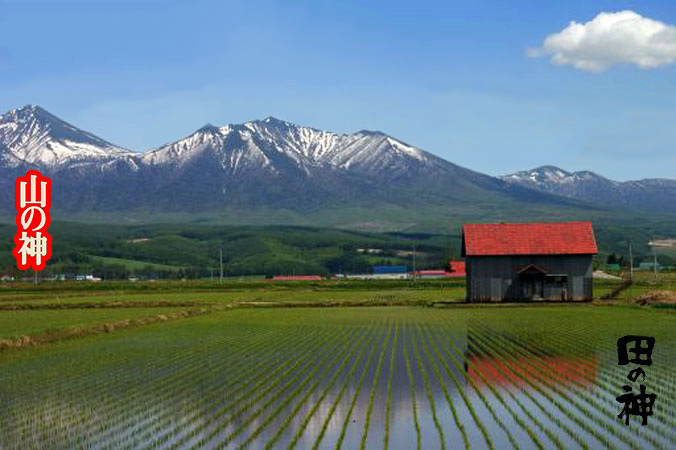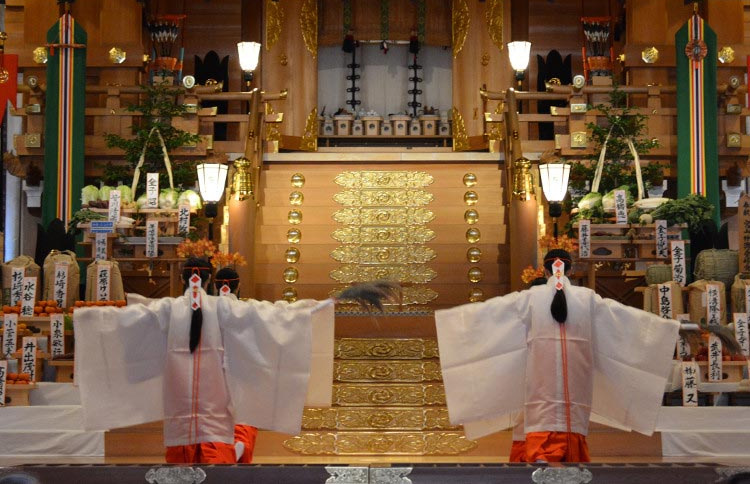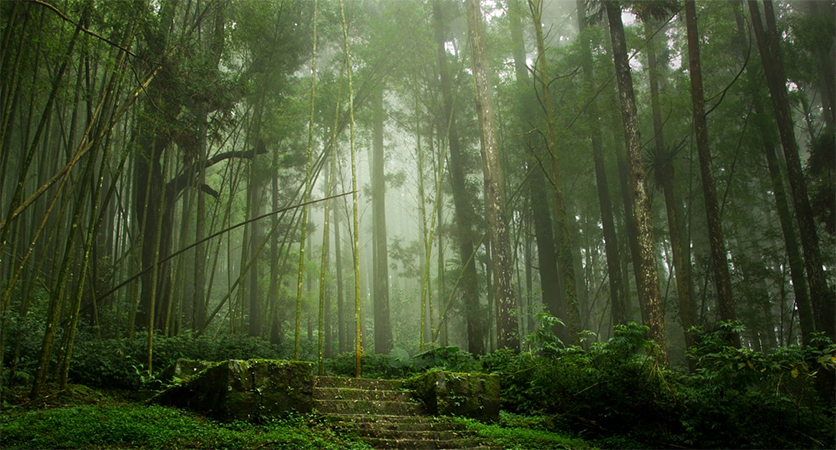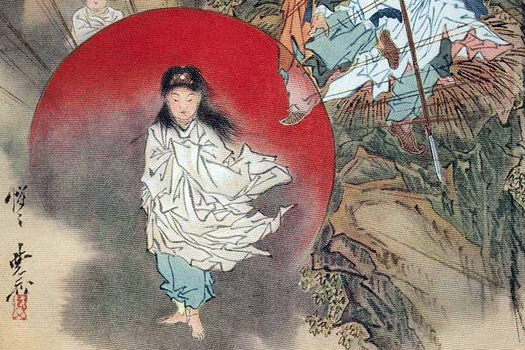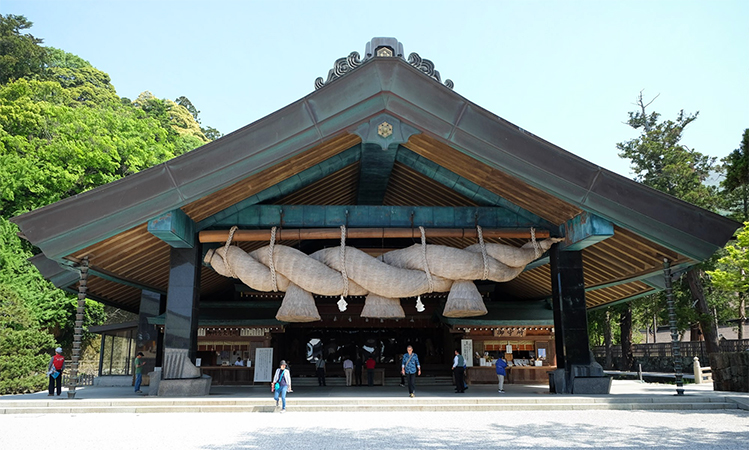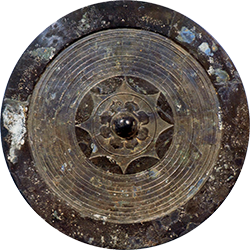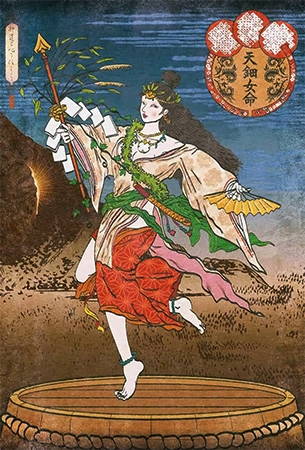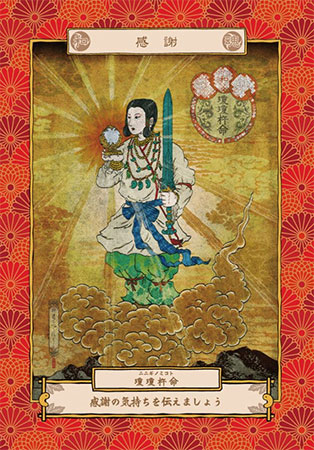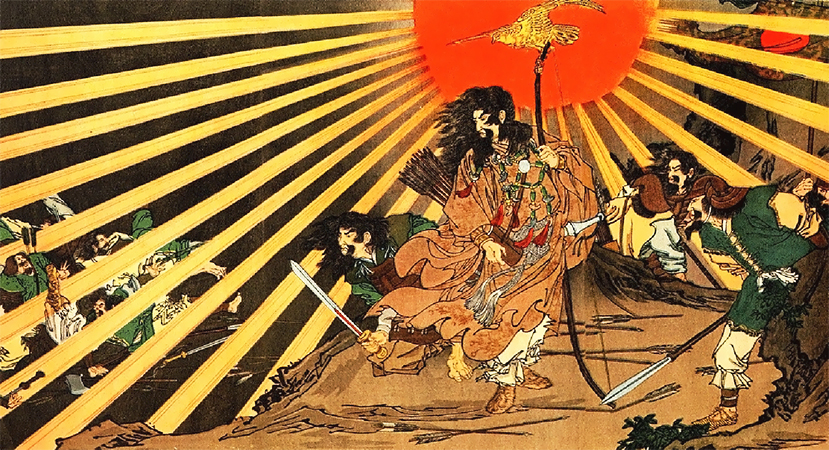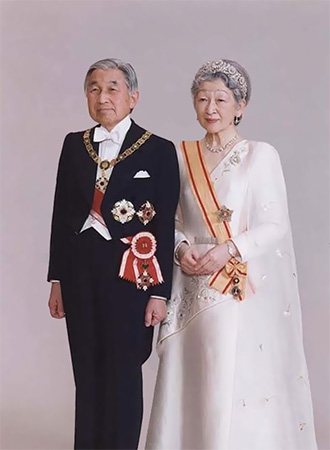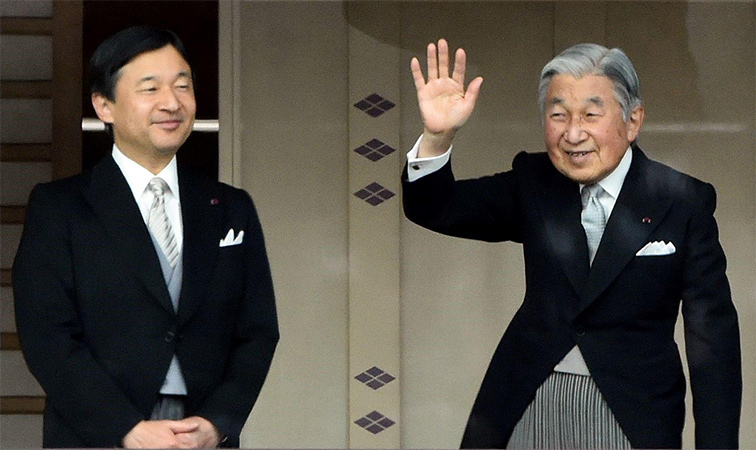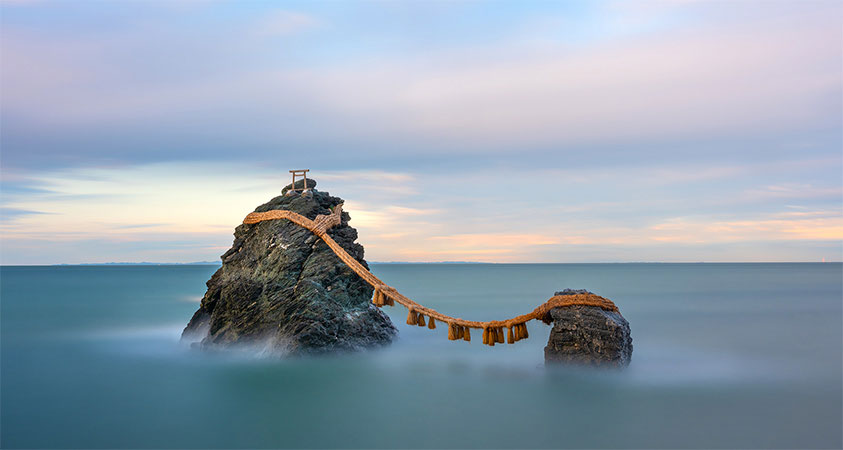In its earliest form, the people of a particular
region
established a symbiotic relationship with the powers of nature that
were
responsible for protecting the community. For example, since water
flows from the mountains to the fields, this natural cycle was
personified as a kami of the mountain (yama no kami) that descended in the spring to become the kami
of the field (ta no kami), which then returned to the mountain after the fall harvest. People therefore offered “first fruits” to this local kami
in order to ensure the protection of the community.
Otaue Matsuri (Rice Planting Festival)
Niiname Sai (First Taste Festival)
This idea of living in harmony with kami of the natural world is known as kannagara, which Yukitaka Yamamoto, ninety-sixth Chief Priest of the Tsubaki Grand Shrine, describes as follows:
| The Spirit of Great Nature may be a flower, may be the
beauty of the mountains, the pure snow, the soft rains or the gentle breeze. Kannagara means being in communion with these forms of beauty
and so with the highest level of experiences of life. When people
respond to the silent and provocative beauty of the natural order, they
are aware of kannagara. When they respond in life in a similar way, by
following ways “according to the kami,” they
are expressing kannagara in their lives. They are living according to
the natural flow of the universe and will benefit and develop by so
doing. (Living Religions, 226) |
 |
|
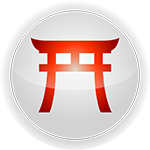
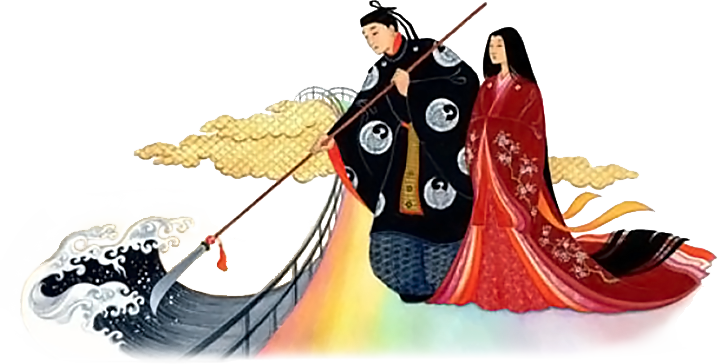
Shinto & the State
The Birth of Japan
Izanagi
and Izanami stood on the floating
bridge
of Heaven and held counsel together, saying, “Is there not a country
beneath?” Thereupon they thrust down the jewel-spear of Heaven
and, groping about therewith,
found the ocean. The brine which dripped from the point of the
spear
coagulated and became an island which received the name of
Ono-goro-jima. The two deities thereupon descended and dwelt in this
island. (Sources of Japanese Tradition, 14)
How is this creation story similar to and/or different from
the more familiar account of "Genesis" in the bible?
|

|
Izanagi no Mikoto and Izanami no Mikoto
consulted
together saying, “We have now produced the great-eight-island country,
with
the mountains, rivers, herbs, and trees. Why should we not
produce
someone who shall be lord of the universe? They then together
produced
the Sun Goddess, who was called O-hiru-me no muchi. (Called in one
writing
Amaterasu no O-hiru-me no muchi.) The resplendent luster of this
child
shone throughout all the six quarters. Therefore the two deities
rejoiced
saying, “We have had many children, but none of them have been equal to
this
wondrous infant. She ought not to be kept long in this land, but
we
ought of our own accord to send her at once to Heaven and entrust to
her
the affairs of Heaven.” (Sources of Japanese Tradition, 20-1) |
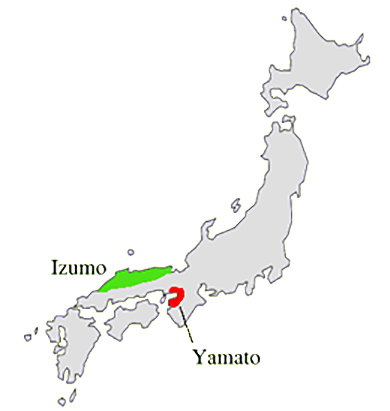
[Izanagi and Izanami’s] next
child was Susa no o no
Mikoto. … This god had
a fierce temper
and was given to cruel acts. Moreover he made a practice of
continually
weeping and wailing. So he brought many of the people of the
land
to an untimely end. Again he caused green mountains to become
withered. Therefore the two gods, his parents, addressed Susa-no-o
no Mikoto,
saying,
“Thou art exceedingly wicked, and it is not meet that thou
shouldst
reign
over the world. Certainly thou must depart far away to the
Nether-land.” So they at length expelled him. (SJT,
20-1)
|

 |
The Yasakani Magatama Jewels & Sacred Mirror
After this Susa-no-o no
Mikoto’s behavior was exceedingly rude. ... [For example,] when he
saw that Amaterasu was in her sacred weaving hall, engaged in weaving
garments of the gods, he flayed a piebald colt of Heaven and, breaking
a hold in the roof tiles of the hall, flung it in. Then Amaterasu
started with alarm and wounded herself with the shuttle. Indignant of
this, she
straightway entered the Rock-cave of Heaven and, having fastened the
Rock-door, dwelt there in seclusion. Therefore constant darkness
prevailed on all sides, and the alternation of night and day was
unknown.
Then the eighty myriad gods met on the bank of
the Tranquil River of Heaven and
considered in what manner they should
supplicate her. ... Then
Ame no Koyane no Mikoto ... and Futo-dama no Mikoto ... dug up a
five-hundred branched True Sakaki tree of the Heavenly Mount Kagu. On
its upper
branches they hung an august five-hundred string of Yasaka [Magatama] jewels. On
the middle branches they hung an eight-hand mirror. ...
Moreover Ame no Uzume no Mikoto,
ancestress of the Sarume
chieftain, took in her hand a spear wreathed with Eulalia grass and,
standing before the door of the Rock-cave of Heaven, skillfully
performed a mimic dance. She took, moreover, the true Sakaki tree
of the Heavenly Mount of Kagu and made of it a head-dress; she took
club-moss and made of it braces; she kindled fires; she placed a tub
bottom upwards and gave forth a divinely inspired utterance.
Now Amaterasu heard this and said, “Since I
have shut myself up in the Rock-cave, there ought surely to be
continual night in the Central Land of fertile reed-plains. How
then can Ame no Uzume no Mikoto be so jolly?” So
with her august hand, she opened for a narrow space the Rock-door
and peeped out. Then Ta-jikara-o no kami forthwith took Amaterasu
by the hand and led her out. Upon this the gods Nakatomi no Kami
and Imibe no Kami at once drew a limit by means of a bottom-tied
rope ... and begged her not to return again [into the cave]. (SJT, 24-25)
|

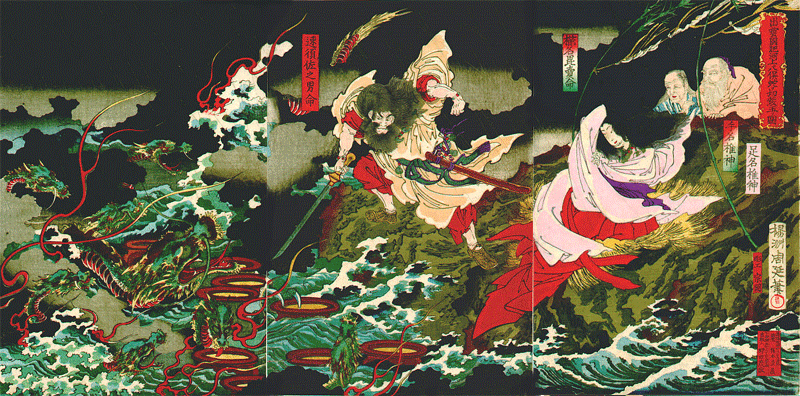
|
|
Susanoo
& the Great Sword
So,
having been expelled, Susa-no-o
descended to a
place [called]
Torikami
at the head-waters of the River Hi in the land of Izumo. [Susa-no
o met
an old male and an old female deity who were weeping because
they had
lost seven daughters to a serpent, which was now about
to take their eighth daughter. Susa-no
o then set out eight pots of sake (rice alcohol); when the serpent arrived, each of its eight heads drank a pot of sake so that it became intoxicated.]
Then
Susa-no
o drew the ten-grasp saber that was augustly girded on him and cut the
serpent in pieces, so that the River Hi flowed on changed into a river
of blood. So when he cut the middle tail,
the edge of his
august
sword broke. Then, thinking it strange, he thrust into and
split
[the flesh] with the point of his august sword and looked, and there
was
a sharp great sword [within]. So he took this great sword,
and
thinking
it a strange thing, he respectfully informed Amaterasu. This is the
Herb-quelling
Great Sword. (SJT, 25-7)
|

|
Ninigi & Jimmu
The Imperial Ancestors
After “all the Central Land of Reed-Plains” was
completely “tranquilized,” Amaterasu gave her grandson, Ninigi, the Three Treasures (a
curved jewel, a mirror, and a sword) and sent him down to rule the
earth, saying: “This ... Land
is the region which my descendants shall be lords of. Do thou, my
August Grandchild, proceed thither and govern it. Go! And may
prosperity attend thy dynasty,
and may it, like Heaven and Earth, endure for ever.” (Sources of Japanese Tradition, 28)
| According to tradition, Ninigi’s Great Grandson,
Jimmu,
went on to become the first “emperor” of Japan in 660 B.C.E. The
present emperor of Japan, Naruhito, is said to be a direct descendent of this
lineage, which is ultimately traced back to the kami Amaterasu. |
|
 | In addition to the deities discussed above, the term kami refers to “the spirits that abide in and are worshipped
at the shrines. In principle human beings, birds, animals, trees,
plants, mountains, oceans — all may be kami. According to ancient
usage, whatever seemed strikingly impressive, possessed the quality of
excellence, or inspired a feeling of awe was called kami.” (Motoori Norinaga, quoted in The
Sacred Paths of the East, 247) |
 Mt. Fuji, One of the Oldest and Most Venerated "Nature" Kami
Mt. Fuji, One of the Oldest and Most Venerated "Nature" Kami
Nachi Waterfall at the Kumano Nachi Shrine
The "Wedded Rocks" (Representing Izanagi and Izanami) at Futami no Ura

Sacred Tree With a Shimenawa (Rice-Stalk Rope to Ward Off Evil Spirits) Ise Grand Shrine, Dedicated to the Sun Goddess Amaterasu
Ise Grand Shrine, Dedicated to the Sun Goddess Amaterasu

Impurity

Purification
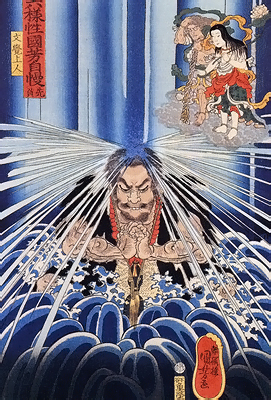 |
 In the traditions collectively referred to as Shinto or kannagara,
the world is beautiful and full of helpful spirits. ... However, ritual
impurity is a serious problem that obscures our originally pristine
nature; it may offend the kami and bring about calamities, such as
drought, famine, or war. The quality of impurity or misfortune is
called tsumi or kegare.
It can arise through contact with low-level spirits, negative energy
from corpses, negative vibrations from wicked minds, hostility toward
others or the environment, or natural catastrophes. In contrast to
repentance required by religions that emphasize the idea of human
sinfulness, tsumi
requires purification. The body and mind must be purified so that the
person can be connected with kami that are clearn, bright, right, and
straight. (Living Religions, 231) In the traditions collectively referred to as Shinto or kannagara,
the world is beautiful and full of helpful spirits. ... However, ritual
impurity is a serious problem that obscures our originally pristine
nature; it may offend the kami and bring about calamities, such as
drought, famine, or war. The quality of impurity or misfortune is
called tsumi or kegare.
It can arise through contact with low-level spirits, negative energy
from corpses, negative vibrations from wicked minds, hostility toward
others or the environment, or natural catastrophes. In contrast to
repentance required by religions that emphasize the idea of human
sinfulness, tsumi
requires purification. The body and mind must be purified so that the
person can be connected with kami that are clearn, bright, right, and
straight. (Living Religions, 231)
The
Western idea of sin generally involves intent; sin usually cannot be
accidental. The Shinto idea of defilement, by contrast, is more akin to
what we find in taboo cultures — that is, the contact itself is the
polluting factor regardless of whether the person knew about the
offense or undertook the action voluntarily. ... In the symbolic
language introduced in the previous chapter, we could say the
mirrorlike mindful heart is soiled (perhaps through no fault of its
own) and cannot reflect the kami-filled
world. Things will not go right from this point forward — the only
solution is a purification ritual to eradicate the pollution or
defilement. (SWH, 47-8)
What are the implications of focusing on "defilement" rather than "sin"?
|
Misogi (Ablution)

Harae/Oharai (Purification Rituals)
 |
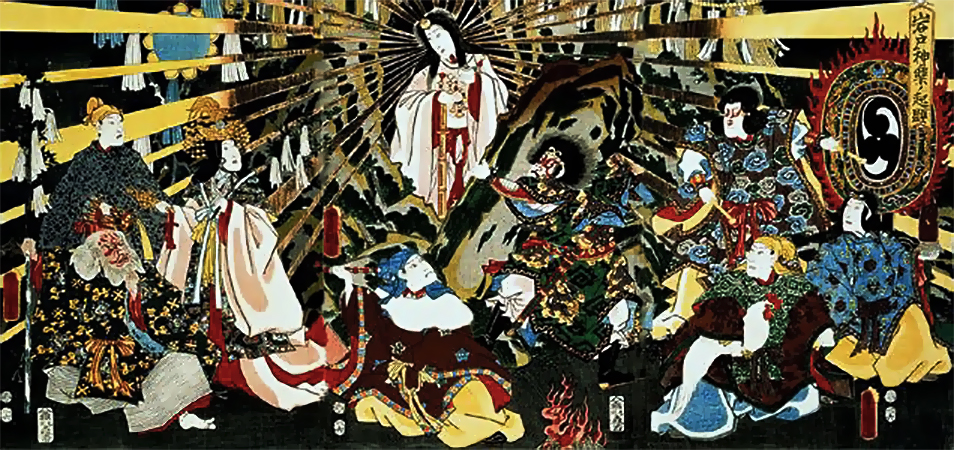



 In the traditions collectively referred to as Shinto or kannagara,
the world is beautiful and full of helpful spirits. ... However, ritual
impurity is a serious problem that obscures our originally pristine
nature; it may offend the kami and bring about calamities, such as
drought, famine, or war. The quality of impurity or misfortune is
called tsumi or kegare.
It can arise through contact with low-level spirits, negative energy
from corpses, negative vibrations from wicked minds, hostility toward
others or the environment, or natural catastrophes. In contrast to
repentance required by religions that emphasize the idea of human
sinfulness, tsumi
requires purification. The body and mind must be purified so that the
person can be connected with kami that are clearn, bright, right, and
straight. (Living Religions, 231)
In the traditions collectively referred to as Shinto or kannagara,
the world is beautiful and full of helpful spirits. ... However, ritual
impurity is a serious problem that obscures our originally pristine
nature; it may offend the kami and bring about calamities, such as
drought, famine, or war. The quality of impurity or misfortune is
called tsumi or kegare.
It can arise through contact with low-level spirits, negative energy
from corpses, negative vibrations from wicked minds, hostility toward
others or the environment, or natural catastrophes. In contrast to
repentance required by religions that emphasize the idea of human
sinfulness, tsumi
requires purification. The body and mind must be purified so that the
person can be connected with kami that are clearn, bright, right, and
straight. (Living Religions, 231)